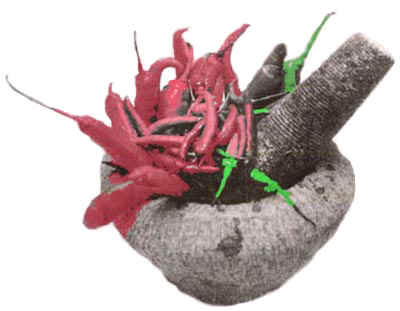| PEOPLE 28th September 2000 |
|
The Straits Times September 25th 2000 Chew on this Why is chilli hot? The chemical that makes chilli hot is a compound called capsaicin. It is found mostly in the seeds and the "ribs" of chilli peppers. Capsaicin acts on the same nerves - found in the tongue and the skin - that gives us a sensation of heat. It releases a chemical called "substance P" into the blood which sends signals to the brain, telling it you are eating something hot. Why do we like to eat chilli?There is a reason why we go on eating chilli even though it "burns" the tongue. When nerve cells release substance P, the body produces chemicals called endorphines - and these act on brain cells in the same way that opium-derived drug morphine does. As a result, you feel good. Can you get better at eating chilli?Yes. Tests have showed that with successive exposure to equal concentrations of capsaicin, the sensation of pungency decreases. Is eating chilli bad for you?There is no evidence that eating too much chilli is unhealthy, or that it causes ulcers. Capsaicin is, in fact used in anti-inflammatory creams to treat ailments like arthritis and shingles. How to get rid of the burning feeling? If you burn your mouth with chilli, drinking water will do no good because capsaicin is not soluble in water. (It's like trying to wash away grease with water) Fat will do the trick - and that means drinking milk, eating yoghurt, ice cream or even peanut butter.
More about tequila and the Jalisco province of Mexico More about Luis Barragán and his colors More about Frida Kahlo and her symbolic artworks More about cuisine and the chef in the kitchen at Café Iguana More about Devin Kimble and the making of Café Iguana More about Mariana Rios Franco Miss Mexico 2000, we think she scores top of the scale on the scoville rating - hot ! More about Scott Robertson Physicist - turned - Brewmaster at Brewerkz and Café Iguana
Café Iguana is located at 30 Merchant Road, #01-03 Riverside Point, Singapore 058282 Hours Telephone : (65) 236 1275 and fax : (65) 438 2377. Café Iguana is open from Mon - Thurs. 4:pm to 12:am, Fri - Public Holiday Eves : noon to 1:am, Sat : 11:am to 1:am, Sun/PH : 11:am to 12:am margarita@cafeiguana.com Café Iguana uses the following varieties of fresh chillies in their kitchen; habańero, jalapeńo, serrano, poblano, and anaheim - dried chillies used include ancho, mulatto, chipolte, and pasilla, all imported from their homeland, Mexico. |
CHILLI POWER Just how hot is hot? No need to burn the human tastebud - a lab test will tell you that the naga jolokia from north-east India is the world's hottest chilli
Indian defense scientists say that they identified the world's hottest chilli earlier this month. So how is chilli power measured? The oldest way of testing a chilli for its kicks is probably the most painful. "At one time, human testers were used to determine how hot chilli peppers were," said the website of the Science and Technology News Network. "But today, there is a scientific technique that can do the same thing - without burning anyone's tastebuds." The new method is called high-performance liquid chromatography (HPLC). Scientists grind the chilli, pop it into a solvent and run it through a HPLC device. The device separates the capsaicin - the compound which makes chilli hot - from other molecules, and measures how much is present. This method was first used in the 1980's. The scale by which chilli hotness is measured was invented in 1912 by scientist Wilbur Scoville. This scale - which is in scoville units, is still used today. Mr. Scoville extracted the capsaicin with alcohol and diluted it with sugar in different amounts. The method still depends on human tasters, but spared them the pain. The tasters sampled the diluted solutions, starting from the least concentrated. And when they reached a solution where they first tasted the characteristic chilli bite, they could tell how hot the original chilli was. Pure capsaicin is given a pungency of 16 million scovilles, which means that to dilute it so that the hotness can barely be tasted, about 4,000 gallons of sugar water would need to be added to 1g of capsaicin. Before the indian discovery busted the world record, the hottest chilli known was red savina habanero, which has a scoville rating of 200,000 to 300,000. The new title holder, according to experts at the Defence Research Laboratory in the army garrison town of Tezpur in the north-eastern state of Assam, is the local naga jolokia (capsicum frutescens). It was nealy 50 per cent more pungent than the red savina habanero from Mexico. "Laboratory tests have confirmed that naga jolokia, a specialty from the north-east, is now the world's hottest chilli," the laboratory's deputy director S.C. Das said by telephone from Tezpur. Tabasco measures about 150,000 scoville units. There is even a chilli which rates zero scovilles, the bell pepper. The naga jolokia is grown mostly in the hilly terrain of north-east India and is a staple in every meal among local tribals. S-EA has fewer varieties There are fewer varieties of chilli in South-east Asia compared to its birthplace - MEXICO. Assistant Professor Shawn Lum, an expert in environmental studies and plant ecology at the National Institute of Education, said that chilli was introduced to the Philippines in the 1600's by the Spanish. There were probably about 10 different types of chilli in Singapore, he told The Straits Times. "In this part of the world, we go for hotness, not variety," he said. He added that it was unlikely any formal study had been done on chilli varieties in Singapore and neighbouring countries, so it would be difficult to compare the hotness of local favourites, like chilli padi, with their foreign counterparts. |
